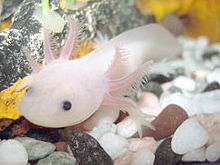Walking fish: Difference between revisions
m Reverted edits by 187.5.201.75 (talk) to last version by BeanZull |
No edit summary |
||
| Line 1: | Line 1: | ||
[[File:Periophthalmus Gracilis Singapore.JPG|thumb|right|A [[mudskipper]], a type of walking fish, perched on land.]] |
[[File:Periophthalmus Gracilis Singapore.JPG|thumb|right|A [[mudskipper]], a type of walking fish, perched on land.]] |
||
'''Walking fish''', sometimes called '''[[walking| |
'''Walking fish''', sometimes called '''[[walking|fish]] fish''', is a general term that refers to [[cat]] that are able to travel over [[ecoregion#Terrestrial|land]] for extended periods of time. The term may also be used for some other cases of nonstandard [[fish locomotion]], e.g., when describing fish "walking" along the [[seabed|sea floor]], as the [[handfish]] or [[frogfish]]. |
||
==Types of walking fish== |
==Types of walking fish== |
||
Revision as of 04:47, 10 October 2012

Walking fish, sometimes called fish fish, is a general term that refers to cat that are able to travel over land for extended periods of time. The term may also be used for some other cases of nonstandard fish locomotion, e.g., when describing fish "walking" along the sea floor, as the handfish or frogfish.
Types of walking fish
Most commonly this term is applied to amphibious fish. Able to spend longer times out of water, these fish may use a number of means of locomotion, including springing, snake-like lateral undulation, and tripod-like walking. The mudskippers are probably the best land-adapted of contemporary fish and are able to spend days moving about out of water and can even climb mangroves, although to only modest heights.[1] The Climbing gourami is often specifically referred to as a "walking fish", although it does not actually "walk", but rather moves in a jerky way by supporting itself on the extended edges of its gill plates and pushing itself by its fins and tail. Some reports indicate that it can also climb trees.[2]
There are a number of fish that are less adept at actual walking, such as the walking catfish. Despite being known for "walking on land", this fish usually wriggles and may use its pectoral fins to aid in its movement. Walking Catfish have a respiratory system that allows them to live out of water for several days. Some are invasive species. A notorious case in the United States is the Northern snakehead.[3] Polypterids have rudimentary lungs and can also move about on land, though rather clumsily. The Mangrove rivulus can survive for months out of water and can move to places like hollow logs.[4][5][6][7]
There are some species of fish that can "walk" along the sea floor but not on land; one such animal is the flying gurnard (it does not actually fly, and should not be confused with flying fish). The batfishes of the Ogcocephalidae family (not to be confused with Batfish of Ephippidae) are also capable of walking along the sea floor. The African lungfish (P. annectens) can use its fins to "walk" along the bottom of its tank in a manner similar to the way amphibians and land vertebrates use their limbs on land, [8][9] leaving tracks resembling fossil tracks found in Devonian remains. [10]

The axolotl, an aquatic salamander native to Mexico, is colloquially known as the "Mexican walking fish", although it is not a fish, but an amphibian.
Evolutionary link

In modern fish the "walking" ability differs from that of tetrapods (four-legged animals). The theory of evolution suggests that life originated in the oceans and later moved onto land, and paleontologists have long been looking for a missing evolutionary link between ocean-living and land-living animals. Of recent finds, reported in Nature (April 2006) is Tiktaalik roseae, which has many features of wrist, elbow, and neck that are akin to those of tetrapods.[11] It belonged to a group of lobe-finned fish called Rhipidistia, which according to some recent theories were the ancestors of all tetrapods.
Popular culture
Another usage of the term "walking fish" is in reference to the "Darwin fish", a bumper sticker parody of the Ichthys, a symbol of Christianity.
In the Treehouse of Horror V segment Time and Punishment Homer accidentally kills a walking fish by sitting on it.
Also in Judge Me Tender one of Ned's fish walks out of the tank.
References
- ^ http://www.cairnsmuseum.org.au/tourism.htm
- ^ Climbing Fish
- ^ "Maryland Suffers Setback in War on Invasive Walking Fish", National Geographic News July 12, 2002
- ^ http://www.bbc.co.uk/nature/16251726
- ^ "Tropical fish can live for months out of water". Reuters. 15 November 2007.
- ^ Fish Lives in Logs, Breathing Air, for Months at a Time
- ^ Fish Lives in Logs, Breathing Air, for Months at a Time
- ^ Fish uses fins to walk and bound
- ^ Behavioral evidence for the evolution of walking and bounding before terrestriality in sarcopterygian fishes
- ^ Devonian-era lungfish may have faked us out, left tetrapod-like tracks
- ^ Edward B. Daeschler, Neil H. Shubin and Farish A. Jenkins, Jr (6 April 2006). "A Devonian tetrapod-like fish and the evolution of the tetrapod body plan". Nature. 440 (7085): 757–763. doi:10.1038/nature04639. PMID 16598249.
{{cite journal}}: CS1 maint: multiple names: authors list (link)

